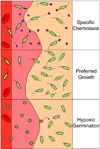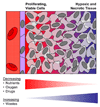Bacterial therapies: completing the cancer treatment toolbox
- PMID: 18760353
- PMCID: PMC2600537
- DOI: 10.1016/j.copbio.2008.08.004
Bacterial therapies: completing the cancer treatment toolbox
Abstract
Current cancer therapies have limited efficacy because they are highly toxic, ineffectively target tumors, and poorly penetrate tumor tissue. Engineered bacteria have the unique potential to overcome these limitations by actively targeting all tumor regions and delivering therapeutic payloads. Examples of transport mechanisms include specific chemotaxis, preferred growth, and hypoxic germination. Deleting the ribose/galactose chemoreceptor has been shown to cause bacterial accumulation in therapeutically resistant tumor regions. Recent advances in engineered therapeutic delivery include temporal control of cytotoxin release, enzymatic activation of pro-drugs, and secretion of physiologically active biomolecules. Bacteria have been engineered to express tumor-necrosis-factor-alpha, hypoxia-inducible-factor-1-alpha antibodies, interleukin-2, and cytosine deaminase. Combining these emerging targeting and therapeutic delivery mechanisms will yield a complete treatment toolbox and increase patient survival.
Figures



References
-
- Jain RK. The next frontier of molecular medicine: delivery of therapeutics. Nat Med. 1998;4:655–657. - PubMed
-
- Brown JM, Giaccia AJ. The unique physiology of solid tumors: opportunities (and problems) for cancer therapy. Cancer Res. 1998;58:1408–1416. - PubMed
-
- Tannock IF, Lee CM, Tunggal JK, Cowan DS, Egorin MJ. Limited penetration of anticancer drugs through tumor tissue: a potential cause of resistance of solid tumors to chemotherapy. Clin Cancer Res. 2002;8:878–884. - PubMed
-
- Forbes NS. Profile of a bacterial tumor killer. Nat Biotechnol. 2006;24:1484–1485. - PubMed
-
-
Kasinskas RW, Forbes NS. Salmonella typhimurium lacking ribose chemoreceptors localize in tumor quiescence and induce apoptosis. Cancer Res. 2007;67:3201–3209.* Using cylindroid models, the authors showed how chemotaxis worked in Salmonella to target different regions in tumors. Aspartate receptors initiate bacterial migration toward cylindroids, serine receptors launch penetration, and ribose/galactose receptors direct Salmonella into necrotic regions. This was a first attempt to explain the tumor targeting mechanism of motile anaerobes. New generic sites that can be engineered to improve tumor targeting efficacy were proposed as well.
-
Publication types
MeSH terms
Substances
Grants and funding
LinkOut - more resources
Full Text Sources
Other Literature Sources

